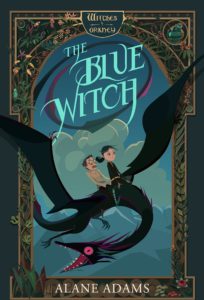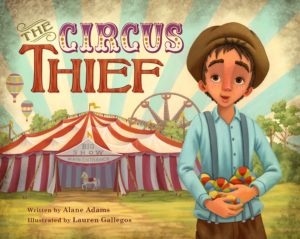“And They Lived Happily Ever After”
In the author talk I give to middle grade students, I like to ask why most books have happy endings. The typical answer I get is, “The good guy always wins, everyone knows that!” But then I challenge them to ask themselves why that is. Why is it that when Harry Potter faces off against Voldemort in the epic final wand battle, Voldemort is the one who gets blasted away and not Harry? Voldemort is, after all, the most powerful dark lord in all of Potterdom history and Harry is just a wizard boy. The answer I believe lies in the deeper reasoning behind why authors write books and the close relationship that develops between the reader and the hero/heroine in the story.
To simplify the general structure of a story involves a Main Character who encounters some kind of Problem (conflict) early on and the remainder of the book is about the Main Character taking steps, forward and backward, to solve the Problem. So, a book can be labelled as Character-Problem-Solution. There are of course many other elements but for simplicity, let’s focus on those three elements to see how they lead to happy-ever-after’s.
Beginning with the Main Character, it is important to keep in mind that when an author creates the central character, he or she is typically designed to appeal to the ideal reader. The character must be someone the reader can easily identify with and connect to, otherwise they are unlikely to turn the pages and continue reading. Harry Potter was written for kids so JK Rowling introduces him starting at age eight. Readers of Harry Potter reported feeling sorry for the mistreated boy who lived under the stairs and wanting to learn more about his fate. Suzanne Collins created an instant connection to her ideal teenaged reader by having Katniss Everdeen share on the very first page of the novel The Hunger Games that she not only disliked the family cat, Buttercup, but wished she had drowned it as a kitten. That kind of ugly internal thought can immediately reassure an angsty teen that this character is like them, filled with flaws, and not some hero sitting high on a perch. This allows an important connection to take place between the reader and the character. In my book The Red Sun, 12-year-old Sam Baron has a problem with his temper, and every time he loses it, things get worse, which is instantly relatable for those pre-teens struggling with emotions.
Next, the main character encounters a Problem. The bigger the problem, the bigger the character must rise up to be in order to defeat or solve the problem. Harry had a singular problem throughout the entire series—Voldemort wanted Harry dead. Had Voldemort been a clerk at the local wand store, it would have been a minor bump in the road, but Voldemort was the most powerful wizard lord in all of Potterdom, and as he grows in power, so too must Harry in order to survive. Katniss Everdeen has a huge problem—it’s not a fight to the draw, it’s a fight to the death in the Hunger Games, and the odds of her surviving are extremely low. Sam Baron also has a big problem-his temper has triggered an ancient curse that affects the sun, arguably one of the most powerful objects in our universe, and every time Sam loses his temper, another red vein appears across the face of the sun, poisoning the land, until.…everyone….is….going…..to…..die… because face it, if everyone was going to get a bad sunburn, the stakes wouldn’t be as high and the reader’s emotions wouldn’t be as charged.
As the pages fly by, the Main Character attempts to solve the Problem—sometimes stumbling, sometimes making progress, but along the way, a magical thing takes place. If someone were to ask you to read their mind, you could guess at what they were thinking, but they could always lie and say you were wrong. We don’t always tell the truth about what we’re thinking. But all that changes when we read a book. We are invited into the point of view of the character and so we know exactly what they are thinking—if they are scared, cold, angry, in pain, lying, or filled with remorse. Every single emotion or thought they have, ugly or not, is shared with the reader so that they know this character inside and out. If the author has done their job right and created a character the reader connects with, and then takes them on an intimate journey of sharing the adventures together, it makes sense that upon arriving at the grand finale, the reader is going to be rooting for that Main Character to win the day. And while there is no law that states the author must deliver on this promise, I believe that authors don’t write books to rip out the hearts of their readers, but rather, they write books to deliver hope, that if Harry can defeat Voldemort, I can win my battles. If Katniss can survive the Hunger Games, maybe I can survive high school. If Sam can defeat the curse hanging over his head, maybe I can defeat the cloud of doubt hanging over mine. If in the end, the Main Character fails to solve their Problem, we leave our reader with a depressingly familiar message—life isn’t fair—and things don’t always work out. We read books to escape, to have an adventure, to feel something powerful, but in the end, we want to cling to our beliefs that there is good to be found, and hope abounds.
About the Author: Alane Adams is an author, former professor, literacy advocate and founder of Rise Up Foundation. She is the author of the Legends of Orkney fantasy mythology series for tweens and The Coal Thief, The Egg Thief, and The Santa Thief picture books for early-grade readers. Her newest books, The Blue Witch, first in The Witches of Orkney series (a prequel trilogy for middle grade readers) and The Circus Thief, a picture book for young readers, will be published by SparkPress in Fall 2018. Alane travels the country each year, visiting hundreds of students, bringing a fun and inspirational program to motivate readers. She welcomes the chance to come to your school. Learn more about Alane Adams and request a free school visit at www.alaneadams.com.
The Blue Witch
Published October 23rd, 2018 by SparkPress
About the Book: Before Sam Baron broke Odin’s curse on the witches to become the first son born to a witch and the hero of the Legends of Orkney series, his mother was a young witchling growing up in the Tarkana Witch Academy. In this first book of the prequel series, the Witches of Orkney, nine-year-old Abigail Tarkana is determined to grow up to be the greatest witch of all, even greater than her evil ancestor Catriona. Unfortunately, she is about to fail Spectacular Spells class because her witch magic hasn’t come in yet. Even worse, her nemesis, Endera, is making life miserable by trying to get her kicked out.
When her new friend Hugo’s life is put in danger by a stampeding sneevil, a desperate Abigail manages to call up her magic―only to find out it’s unlike any other witchling’s at the Tarkana Witch Academy! As mysteries deepen around her magic and just who her true parents are, Abigail becomes trapped in a race against time to undo one of her spells before she is kicked out of the coven forever!
Rich in Norse mythology, The Blue Witch is the first of a fast-paced young reader series filled with magical spells, mysterious beasts, and witch-hungry spiders!
The Circus Thief
Illustrator: Lauren Gallegos
Publication Date: November 6th, 2018 by Spark Press
About the Book: The circus is in town, and Georgie has his heart set on going. When Papa agrees to take him and his friend Harley, the boys marvel at the amazing elephants and clowns. But the best act of all is the amazing Roxie, a trained horse who can do all sorts of tricks. When Georgie is invited to ride on her back, he discovers it’s her last show―Roxie is going to be sent to the work farm! When Roxie bolts with Georgie on her back, Papa must come to his rescue.
The Circus Thief is a heartwarming tale of boyhood set in 1920s Pennsylvania.
Thank you, Alane, for this hopeful and insightful post!



